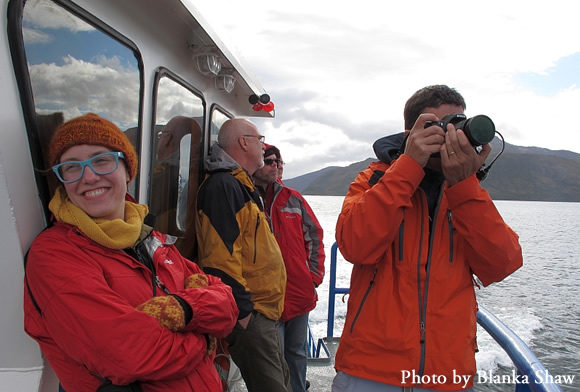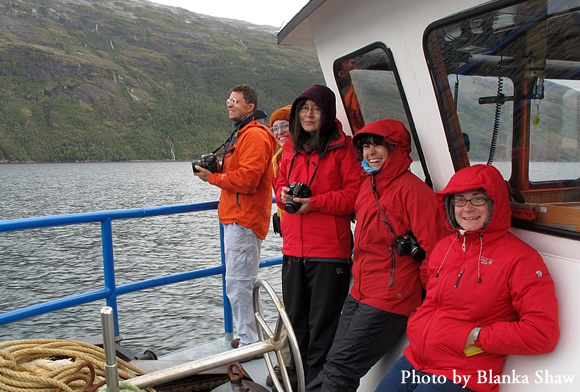From the Field: Bill Buck in Cape Horn, Day 1
Posted in Bill Buck, From the Field, Science on January 31 2012, by William R. Buck
January 17, 2012; Punta Arenas, Chile
As I begin writing, we are pulling away from the main municipal dock in Punta Arenas, and are beginning our 2012 expedition. (Read about all of Bill’s 2011 adventures here.)
We have a large group this year, with eleven scientists and five crew. Out of the ten flying into Punta Arenas, only four made it on time. I arrived eight hours late due to mechanical problems in Atlanta causing me to miss my connection in Santiago. From Santiago I was scheduled to fly to Punta Arenas, on Sky, but when I arrived late, they told me that there was nothing they could do that day and that they had no responsibility to do so. So, I went to the larger airline, Lan, and was able to purchase a new ticket for later that same day; almost surely cheaper than a hotel and dinner in Santiago! When I arrived in Punta Arenas at around midnight, I found an empty airport completely devoid of taxis.
Our Chilean collaborator Juan Larraín, also had a Sky flight to Punta Arenas that was delayed–he was stranded at his layover in Puerto Montt and arrived four hours late. This is not an airline I intend to use again! Matt von Konrat, of the Field Museum in Chicago, also found himself delayed and had to spend the night in Dallas/Fort Worth. He arrived about eight hours late, finally landing in Punta Arenas around 3 a.m. After my late-night, taxi-less arrival, I knew Matt would have the same problem. Seeing as he speaks very little Spanish, Juan and I arranged for a taxi to pick us up at our hotel at 2:15 a.m., take us to the airport, wait, and bring us all back to the hotel. When Matt arrived in the baggage claim area, he looked very tired and weary, but his facial expression changed immediately to one of relief when he spotted us waiting for him.

Returning for a second expedition is Blanka Shaw from Duke University, as well as Matt (who has made a really great project website), Juan, and our facilitator/scientist, Ernesto Davis. I don’t think I can count how many trips Ernesto made to the airport, especially with all the missed and canceled flights. He is our hero.
In the end, the majority of the other participants were less delayed, and by the evening of Sunday, January 15, all but one of our group had arrived. Xiaolan He, from the Finnish Museum of Natural History, University of Helsinki arrived on the same flight as Blanka. Ricardo Garilleti of the University of València, Spain is traveling with us on a grant from the Spanish government to study the moss genus Ulota, and so although we are paying for his ship costs, he is paying his own in-town expenses. Mauricio Bonifacino from Uruguay is participating on the just the first half of the expedition to collect vascular plants (as opposed to the non-vascular bryophytes that we are after). Mauricio was able to join us after I had a late cancellation, but due to family obligations, he is unable to participate in the whole trip. Also joining us is Laura Briscoe, a graduate student working on hepatics at the Field Museum, and Lily Lewis, a graduate student working on mosses at the University of Connecticut. Rounding out our group is Manuela Mendez, a graduate student from the Universidad de Concepción in Chile who works on alpine plants, both vascular and bryophytic.

For those who followed last year’s expedition on the blog, you may have noticed that I haven’t yet mentioned the weather. In 2011, it was a constant and primary topic. This year is warmer and drier with less wind than usual. I don’t know if it will hold out, but I do not think a single one of us would object to a bit less precipitation than we had last year!
Our focus this year is the second quarter of our flora area, just east of where we worked last year. In basic terms it is the north shore of Isla Gordon and those portions of Isla Grande de Tierra del Fuego north of it, and the south shore of Isla Gordon and the adjacent parts of Isla Hoste south of it. We will also try to hit a number of smaller islands along the way. From studying maps it looks like we should see lots of glaciers this year. We’ve chosen to do the southern half of the area first, along the southwestern portion of the Beagle Channel. We decided to let Mauricio decide which part of the area to explore first since he will only be on the first half of our expedition. We intend to go to travel to the farthest end of our area–near the eastern tip of Isla Gordon–and then work our way back. Our captain, the same man from our trip last year, whom we found so trustworthy and good natured, says it will take about 30 hours at sea to arrive at our starting point. So, we have a lot of time on our hands until we begin collecting. Undoubtedly much time will be spent admiring the spectacular scenery.
Ernesto just came to tell me that our moss dryers are all set up and ready to go. Mauricio is still setting up the dryer he brought to dry his vascular plant collections. So, it appears we are all ready to go. We just need to arrive at our destination. Since we will travel all night, tomorrow we’ll awake well into our flora area and the scenery will change from that of a receding urban environment to a pristine sub-Antarctic landscape. We’re all ready.
Ed. note: NYBG scientist and Mary Flagler Cary Curator of Botany, Bill Buck is currently on expedition to the islands off Cape Horn, the southernmost point in South America, to study mosses and lichens. Follow his journeys on Plant Talk.


Oh how I wish I was there with you! Sounds like a fun group of folks and a great time bryologizing in the very deep south. I look forward to future posts. Keep them coming.
Scott